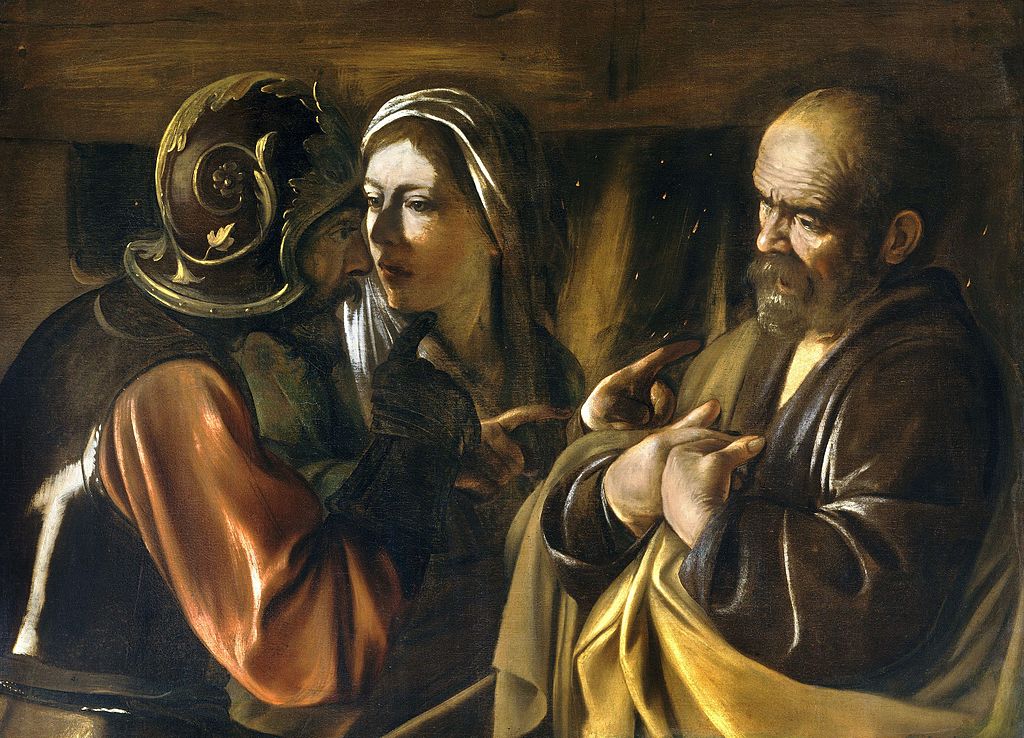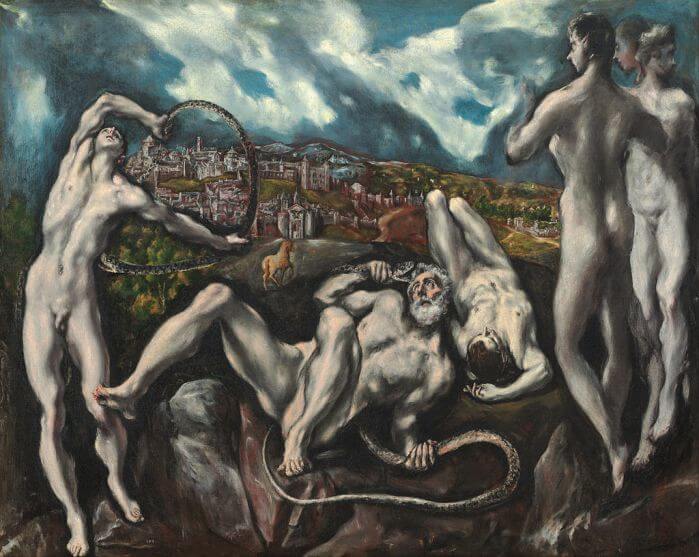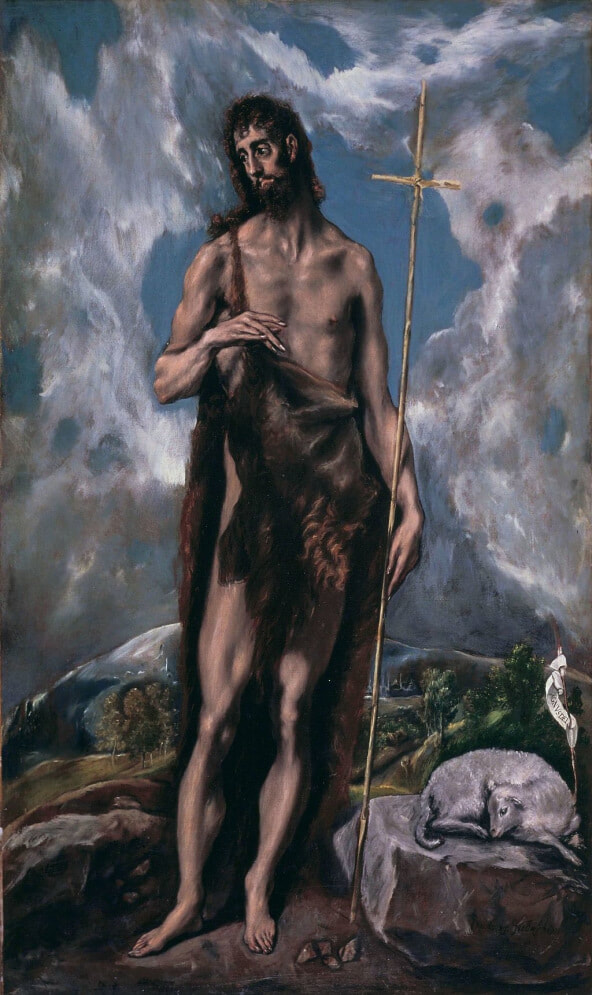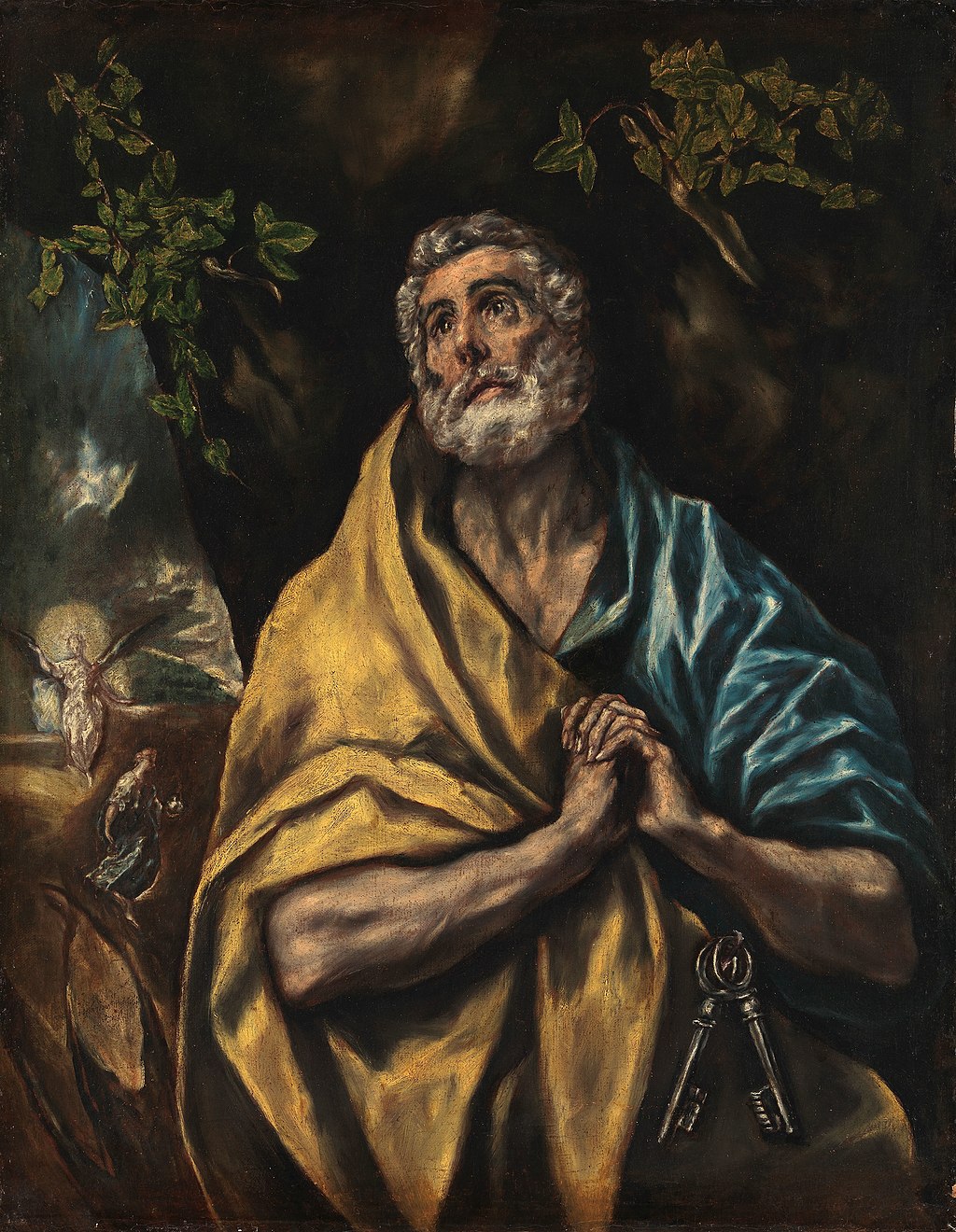|
Where? Room 16 of the San Diego Museum of Art
When? c. 1590-1595 Commissioned by? Unknown What do you see? Saint Peter has his hands folded and looks up to the sky. He has just denied his relation with Jesus three times and severely regrets these denials. He had promised Jesus that he would not deny him and now seeks forgiveness for his actions. He is outside in front of a tree, which is a quiet place where he can express his sorrows. We can recognize Saint Peter by several of his attributes. He has his iconic white bushy hair and beard, and he has the Keys of Heaven around his left arm. El Greco also painted Saint Peter with a characteristic golden robe on top of a blue garment. By using luminous colors for these garments and exaggerating certain features, like the long neck, El Greco succeeded in creating a dramatic, eye-catching image of the repentant Saint Peter. Small scene on the left: On the left, next to the large tree, is another scene. It shows Mary Magdalene returning from the grave of Jesus. We can recognize her by the jar of ointment in her left hand. In front of the grave stands a luminous angel. Mary Magdalene has just discovered that the grave of Jesus was empty and hurries away to tell the news that Jesus was resurrected to Saint Peter and the other disciples. Saint Peter’s Denial: This painting is based on the Biblical stories on Saint Peter denying Jesus three times. The stories are described in the Gospels of Matthew 26, Mark 14, Luke 22, John 13, and John 18. During the Last Supper, just before his crucifixion, Jesus told Peter that he would disown Him three times before the rooster would crow. Saint Peter immediately responded to Jesus by saying that he would never deny his relation with Him. But before dawn, Peter did actually deny Jesus three times. Immediately after the third denial, the rooster crowed for the second time, and Peter realized what he had done. He regretted his actions and started to cry as he realized that Jesus was right with his prediction. The denial of Saint Peter and his repentance have inspired various artists over time. Among them is Caravaggio who painted The Denial of Saint Peter in the Metropolitan Museum of Art.
Backstory: The subject of Saint Peter’s repentance was a popular one in the 16th and 17th century in Catholic countries like Italy and Spain. The Catholic Church wanted to promote the idea of repentance to the people. As people, including Saint Peter, naturally makes mistakes, the Church wanted to let people know that they could admit to their sins and ask God for forgiveness.
Restoration: Initially, this painting in the San Diego Museum of Art only showed the main scene on the penitent Saint Peter. But by comparing this work with similar versions (see below) of this work by El Greco, they suspected that there also had to be a smaller scene on the left side of the painting. Indeed, after a thorough cleaning of the painting, the small scene with Mary Magdelene was discovered. Who is El Greco? Doménikos Theotokópoulos, better known as El Greco, was born in 1541 on the Greek island of Crete. During his youth, he learned about the Byzantine Art that was popular in Greece. When he was 27 years old, he moved to Italy and spent several years in cities like Venice and Rome. Here, he became familiar with Renaissance Art and the works of painters like Michelangelo, Tintoretto, and Titian. In 1577, he moved to Toledo, Spain, where he would spend the rest of his life. He combined his early training in Byzantine Art with the things he learned in Italy to create his own unique style. His use of colors and the strongly elongated features of his subjects distinguish his work from any other artist. Among his works are Laocoön in the National Gallery of Art and Saint John the Baptist in the Legion of Honor Museum.
Fun fact: The subject of Saint Peter’s penitence was close to El Greco’s heart. He painted at least six other versions of this subject which are spread across the world. Two versions are in Toledo, Spain, in the El Greco Museum and the Museo Fundación Lerma. Other versions can be found in the Bowes Museum in England, the Museo Soumaya in Mexico City, the National Gallery of Norway, and the Phillips Collection in Washington.
Written by Eelco Kappe
References:
0 Comments
Leave a Reply. |
Categories
All
|
- Home
- Blog
-
Museums
- Alte Pinakothek
- Art Institute of Chicago
- Baltimore Museum of Art
- Barber Institute of Fine Arts
- Bargello
- Barnes Foundation
- British Museum
- Church of Sant’Anastasia
- Cleveland Museum of Art
- Courtauld Institute of Art
- Detroit Institute of Arts
- Frans Hals Museum
- Galleria Borghese
- Gallerie dell'Accademia
- Getty Museum
- Guggenheim
- Hermitage Museum
- Kunsthistorisches Museum
- Kunstmuseum Basel
- Legion of Honor Museum
- Louvre
- Mauritshuis
- Metropolitan Museum of Art
- Musee d’Orsay
- Museum of Fine Arts in Boston
- Museum of Modern Art
- National Gallery in London
- National Gallery of Art
- National Museum in Poznań
- Norton Simon Museum
- Ny Carlsberg Glyptotek
- Palace of Versailles
- Palazzo Pitti
- Palazzo Vecchio
- Petit Palais
- Philadelphia Museum of Art
- Prado
- Pushkin Museum
- Ravenna Art Museum
- Rijksmuseum
- San Diego Museum of Art
- Santa Maria delle Grazie
- St. Peter's Basilica
- Städel Museum
- Statens Museum for Kunst
- Tate Britain
- Tate Modern
- Timken Museum of Art
- Uffizi
- Vatican Museums
- Wallace Collection
-
Artists
- Altdorfer
- Anguissola
- Berlin Painter
- Bosch
- Botticelli
- Boucher
- Bronzino
- Bruegel the Elder
- Brunelleschi
- Cabanel
- Caillebotte
- Canova
- Caravaggio
- Carpeaux
- Cezanne
- Cimabue
- David
- Degas
- Delacroix
- De Maria
- Donatello
- El Greco
- Fontana
- Fra Angelico
- Fragonard
- Gauguin
- Gentileschi
- Gericault
- Gonzalez-Torres
- Goya
- Hals
- Hogarth
- Hokusai
- Ingres
- Leonardo da Vinci
- Lippi, Filippo
- Longhi, Barbara
- Lorrain
- Makovsky
- Manet
- Massys
- Matisse
- Merian
- Michelangelo
- Mochi
- Modigliani
- Monet
- Panini
- Parmigianino
- Perugino
- Picasso
- Pisanello
- Raphael
- Rembrandt
- Renoir
- Reynolds
- Rivera
- Rodin
- Rubens
- Scultori
- Seurat
- Steen
- Tintoretto
- Titian
- Toulouse-Lautrec
- Turner
- Uccello
- Van der Weyden
- Van Dyck
- Van Eyck
- Van Gogh
- Van Hemessen
- Vasari
- Velazquez
- Vermeer
- Veronese
- Vigée Le Brun
-
Locations
- Books
- About Us








